

 |
 |
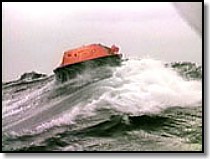 While it may come as a surprise to some, by now most people realize that the survival equipment stocked in most life rafts, even rafts designed to meet SOLAS requirements, is often inadequate, sometimes woefully so. In many cases not only is the selection and quantity a problem, but the quality of the equipment and supplies is also less than desirable.
While it may come as a surprise to some, by now most people realize that the survival equipment stocked in most life rafts, even rafts designed to meet SOLAS requirements, is often inadequate, sometimes woefully so. In many cases not only is the selection and quantity a problem, but the quality of the equipment and supplies is also less than desirable.
Most responsible mariners also stock an Abandon Ship Bag (also called a "ditch bag", "ditch kit", "grab bag", or "flee bag") with additional emergency supplies to take along in case of an abandonment. The question of what supplies to place in the bag provides plenty of stimulating discussion among sailors and boat owners. How much do you really need is always an interesting topic. I've been asked to put together my list of what should be included. I expect this list will also engender its fair share of discussion, which is all to the good. Any list is simply a starting place upon which to measure your own priorities, capabilities, and resources in order to come up with your own list of supplies and equipment.
One subject that is inescapable and always controversial is "cost." Like in most things, assembling a well-equipped Abandon Ship Bag is not cheap. This list was not put together with cost being a determinant. It is not for me to decide what level of expense is sutable for you or where to spend and where to save. Only you can set the value of your life and the lives of your crew and passengers within the scope of your financial limits, a compromise virtually all of us must make.
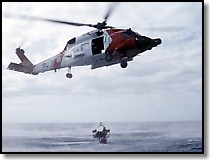 I have organized this list along the lines of my standard survival equipment categories, adding one for "life raft maintenance." The list is annotated with brief comments and linked to other sections of the ETS site where additional information on the subject is available. The scope and quantities of items in this list are based on blue water cruising, the ultimate on-your-own experience, where the possibility exists for an extended stay in the life raft if things should go seriously wrong. The quantities of some items may be reduced somewhat, or eliminated entirely, for coastal use or island hopping in heavily traveled and patrolled waters.
I have organized this list along the lines of my standard survival equipment categories, adding one for "life raft maintenance." The list is annotated with brief comments and linked to other sections of the ETS site where additional information on the subject is available. The scope and quantities of items in this list are based on blue water cruising, the ultimate on-your-own experience, where the possibility exists for an extended stay in the life raft if things should go seriously wrong. The quantities of some items may be reduced somewhat, or eliminated entirely, for coastal use or island hopping in heavily traveled and patrolled waters.
In these circumstances you can shed things that are obviously geared towards longer term survival situations, such as food and fishing gear, for example. You may be able to get by with fewer repair clamps, if you have reasonable expectation of a quick rescue, as another example. In part, these compromises depend on whether you have a 406 EPIRB and back-up hand-held VHF or EPIRB. Close in to shore, reliable and effective communications will substitute for a huge amount of additional gear. Surviving is nice, but getting rescued as quickly as possible is the ultimate aim.
The quantities listed include those that may already be part of the life raft's equipment and survival supplies. However, in some cases the quality of those included items is so poor as to make them irrelevant, so it is important to identify not just what has been packed in the raft generically, but exactly what is in there.
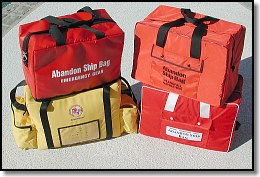 Be sure to carefully examine and test everything you plan to use in an emergency. This ensures you know how to operate the equipment and that it is functioning. Testing is absolutely critical for electronic and mechanical equipment. It isn't pretty when you've abandoned ship and your radio or EPIRB or watermaker doesn't work. It's happened. I've spoken to the survivors, they were not very pleased, but they have only themselves to blame for not testing first. I've seen failures myself in testing. Never rely on mechanical or electronic equipment you haven't tested yourself before packing.
Be sure to carefully examine and test everything you plan to use in an emergency. This ensures you know how to operate the equipment and that it is functioning. Testing is absolutely critical for electronic and mechanical equipment. It isn't pretty when you've abandoned ship and your radio or EPIRB or watermaker doesn't work. It's happened. I've spoken to the survivors, they were not very pleased, but they have only themselves to blame for not testing first. I've seen failures myself in testing. Never rely on mechanical or electronic equipment you haven't tested yourself before packing.
ALL equipment must be fitted with a lanyard, wrist or tether as appropriate. You can't afford to lose anything! Neptune has a seemingly insatiable appetite for your most precious, irreplaceable pieces of survival equipment and supplies. Let him feed off someone else. Everything in the life raft should be secured at all times, either by a lanyard or inside a sealed bag that is securely attached to the raft ("secure" is the watchword!). Neck or wrist lanyards should include a means of adjustment so they can be made tight and secure. If left loose, they can still too easily slip off and the equipment is lost (been there, done that). A useful addition to your equipment list might be a few of Hammerhead Industries' "Gear Keeper" retractable gear attachment systems. They are small, lightweight, easy to use and ensure that whatever you are using doesn't drop overboard, is out of the way when not in use, while still allowing you freedom of movement while using it.
You will find a variety of rectangular duffel-shaped bags sold specifically as Abandon Ship Bags. Kelsey Burr, the original founder of Survival Technologies Group, is generally credited with developing the first purpose-built Abandon Ship Bag which has served as the model for those that have followed.
Now a division of The Patten Group, they still offer essentially the same bag ($95). A bright red rectangular duffel (21 x 12 x 14 inches) of ballistic nylon, it's padded with 1/4 inch closed-cell foam for floatation and protection of the contents. On each side is sewn a 10.5" x 8.25" envelope pocket with a flap closure incorporating two plastic button snaps. A #10 YKK zipper splits the top and extends down the ends seven inches. Two-inch nylon webbing carrying handles are provided. "Abandon Ship Bag" is emblazoned on a patch affixed to the sides.
Some ready-made Abandon Ship Bags claim considerable floatation capability, presumably due to the foam incorporated into their sides and bottom. Don't you depend upon it! Survival Technologies Group claims their bag will "float up to 50 lbs.," however in our pool tests is had only 14 lbs. of inherent floatation. Others we tested, from ACR and West Marine were about the same. Unless the bag is waterproof, and most are not, even a modest load of gear could sink the bag.
The solution is either a fully waterproof dry bag or inclusion of enough less dense materials to ensure you don't overcome the minimal inherent floatation of most of these bags. If you include a substantial quantity of water, which we recommend, that will help since it is less dense than seawater. Packing any excess space with closed cell foam would also help.
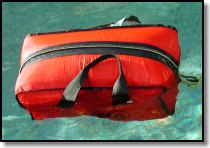 "Dry bags" are one solution and available in a number of configurations, including one specifically marketed as an Abandon Ship Bag by Landfall Navigation. This was the only bag we tested that had enough buoyancy (when closed) to support a decent quantity of weight, its full displacement easily supported 100 lbs of dense materials. That such bags also keep their contents dry is another benefit.
"Dry bags" are one solution and available in a number of configurations, including one specifically marketed as an Abandon Ship Bag by Landfall Navigation. This was the only bag we tested that had enough buoyancy (when closed) to support a decent quantity of weight, its full displacement easily supported 100 lbs of dense materials. That such bags also keep their contents dry is another benefit.
The conclusions from a review I did for Practical Sailor and Powerboat Reports:If the price isn't a problem, Landfall Navigation's Abandon Ship Dri-Bag ($200) is our first choice. We like the fact that it keeps everything dry and that buoyancy isn't a problem. But, it is about twice as expensive and that may be too much for some to swallow. You'll also need to add a tether.
The Survival Technologies bag leaves us unimpressed. Adequate, but for about the same price you can do much better. ACR's RapidDitch has some features we like, the EPIRB pocket being the most significant, but it also has some notable drawbacks that reduce its appeal, most of which, we should note, could be easily fixed.
Of the conventional Abandon Ship Bags, we much prefer West Marine's. It's not overloaded with gimmicky stuff, but it's got well-thought-out features that are practical and work. It's well built and the good tether is icing on the cake. Priced reasonably at a single C-note, it's a good value.
On a related note, the first thing we'd do if we got any one of these bags would be to cut some marine plywood to fit in the bottom of the bag. Carefully sand the edges smooth and seal with polyurethane and you're going to have a much more functional bag. Carrying any significant weight at all in these bags without a solid bottom is no fun. That bottom reinforcement might also be useful later on in a life raft as a cutting board or for other purposes.
Another choice is to use a Pelican Products or Underwater Kinetics case (though these weigh a bit more). They are also hard, which may not be what you want to have alongside you in a life raft.
Any number of other bags or containers can be used, but it's useful if the bag or case is a bright color and is conspicuously labeled as to what it is. Sturdy, easily gripped handles are a must. All such storage containers should have a few feet of lanyard attached with a secure snap clip or carabinier at the end to allow you to quickly attach it to your PFD harness or to the raft so that it doesn't go missing in the chaos that often accompanies an abandonment.
Another good place to store some of this "extra" or replacement equipment or supplies is in the life raft itself, esepcially life raft specific items. When purchasing a new raft or when having your existing raft serviced, take the opportunity to discuss these options with the manufacturer, dealer, or service center. Some manufacturers welcome the opportunity to help in this manner, other simply have a take-it-or-leave-it attitude. Most service centers are happy to assist.
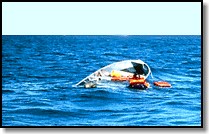 Consider the logistics of an abandonment. Take care that crew members can readily handle the fully loaded bag. Depending upon its size, it's entirely possible to stuff so much in it that it can unwieldy, or even impossible for some persons of smaller stature to lift. Bear in mind also that you might well have to do so on a wildly rolling, slippery deck in perilous conditions. Often it makes sense to split the load into two containers, especially if you have taken to heart admonishments to be well prepared. In some cases, you won't be able to fit the bag(s) in the cockpit, the best location, so at least one of multiple bags may have to go below.
Consider the logistics of an abandonment. Take care that crew members can readily handle the fully loaded bag. Depending upon its size, it's entirely possible to stuff so much in it that it can unwieldy, or even impossible for some persons of smaller stature to lift. Bear in mind also that you might well have to do so on a wildly rolling, slippery deck in perilous conditions. Often it makes sense to split the load into two containers, especially if you have taken to heart admonishments to be well prepared. In some cases, you won't be able to fit the bag(s) in the cockpit, the best location, so at least one of multiple bags may have to go below.
If you do have to split stuff up, how do you decide what goes where? Simply split the amounts or prioritize what goes topside and what goes below? I think prioritizing is probably your best bet. Make sure the most critical gear and supplies are readily at hand. What's most important? Well, that will vary somewhat with the people involved, their capabilities, and where you are. If you compare what the possible consequences of not having something are to other possible inclusions it should become easier to decide, if not exactly easy. Still, lack of some things will surely kill you sooner than lack of others, fresh water vs. food being a prime example.
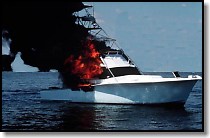 In any case, no matter how well you stock your abandon ship bag, there are going to other items which you need to plan to take with you. Being organized and practice are the only defenses when an emergency occurs. Too often there will be little time to prepare and an abandonment will have to be preformed post-haste, with no time to spare as water pours in or a fire spreads.
In any case, no matter how well you stock your abandon ship bag, there are going to other items which you need to plan to take with you. Being organized and practice are the only defenses when an emergency occurs. Too often there will be little time to prepare and an abandonment will have to be preformed post-haste, with no time to spare as water pours in or a fire spreads.
Crew members should be able to locate and retrieve critical items in the dark -- no different than a soldier being able to field strip his equipment in the dark. Practice, practice, practice. It should take no longer than 30 second for the crew to collect all the gear and be ready to launch the life raft and abandon ship. If that sounds like it's not enough time, talk to a few sailors who have seen their boats go under just that quickly. If you have a plan and practice, it is doable with time to spare.
Will most people invest the time and effort? Unfortunately, probably not, but at a minimum you should do a run-through with the crew before getting underway, so at least everyone has some concept of their responsibilities and what needs doing in the unlikely case that it comes to that. It may help to post an abandon ship checklist in a conspicuous place, perhaps in the companionway.
You should never assume all hands will be available to perform their assigned jobs during the abandonment. Some well-intentioned abandon ship plans fall apart at this point because the developer forgets someone might already have been lost overboard or incapacitated. All crew members should at least be familiar with all that needs to be done and what the priorities are.
|
| SELECT AND USE OUTDOORS AND SURVIVAL EQUIPMENT, SUPPLIES AND TECHNIQUES AT YOUR OWN RISK. Please review the full WARNING & DISCLAIMER about information on this site. |
Publisher and Editor: Doug Ritter
Email: Doug Ritter
URL:
http://www.equipped.org/abandonship.htm
Revision: 010 May 17, 2001
![]()
Email to: [email protected]
|
© 1999, 2000, 2001 Douglas S. Ritter & Equipped To Survive Foundation, Inc. All rights reserved. Check our Copyright Information page for additional information. |
Read the ETS Privacy Policy |